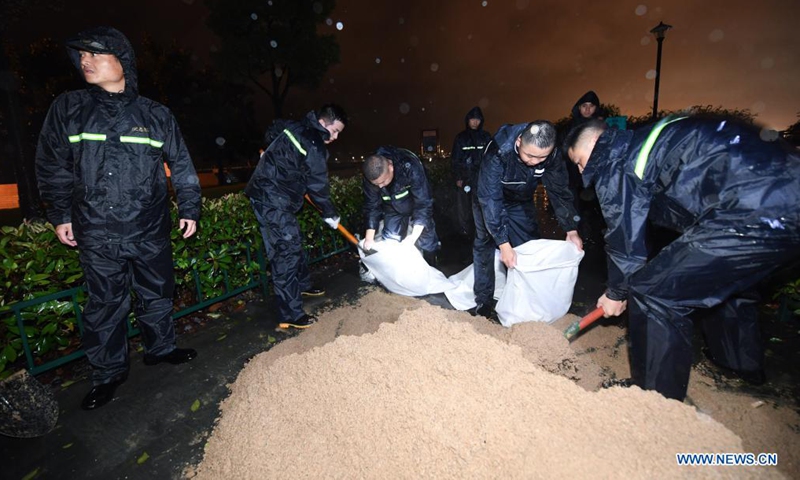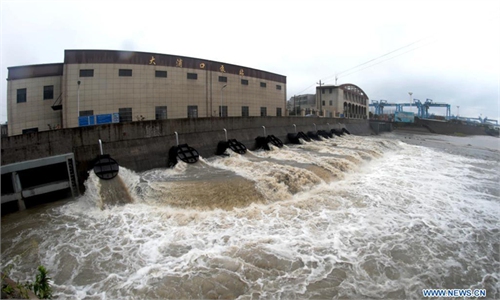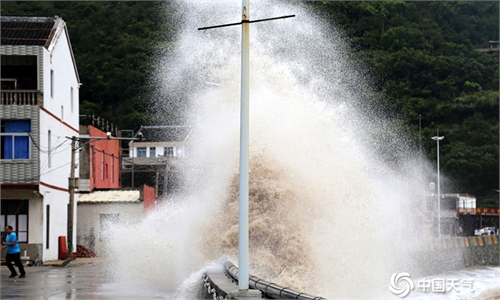More than 1.65 million residents transferred across E. China Zhejiang as Typhoon In-Fa lands twice

Staff pile sandbags to prevent flood at a park in Pinghu, Jiaxing, east China's Zhejiang Province, July 25, 2021. China's national observatory on Sunday continued its orange alert for Typhoon In-Fa, which made landfall in Zhejiang at around Sunday noon. Moving northwestward at about 10 km per hour, In-Fa will make another landfall in coastal areas from Pinghu in Zhejiang Province to Pudong in Shanghai, according to the National Meteorological Center. (Xinhua)
As Typhoon In-Fa made its second landfall on the coast of Pinghua, East China's Zhejiang Province, on Monday morning, China's National Meteorological Center (NMC) said it is estimated that Zhejiang, Shanghai, Jiangsu Province and other East China areas may be hit by strong winds, rain and storm tides. In order to ensure safety for people, 1.65 million residents across Zhejiang have been transferred from risky areas as of Sunday night.
NMC said the typhoon made the second landfall at 9:50 am with a strong tropical storm and a maximum wind force of 10 class near the storm center and a minimum pressure of 978 hpa at the center.
China's National Development and Reform Commission published on Monday an emergency notice on protecting the city's important infrastructure. The notice also requested local authorities to immediately activate highest level of response in case of extreme weather and other unusual conditions.
According to Zhejiang's meteorological station, the accumulative rainfall of Dingjiafan station in Dalan town in Yuyao city reached 951 mm from Thursday 8:00 am to Monday 6:00 am, breaking the rainfall extreme value typhoon landing in a single station in Zhejiang Province.
The province has sent rescue teams to transfer residents from risky areas to emergency shelters as it upgraded its typhoon emergency response to level 1. As of Sunday night, more than 1.65 million residents have been transferred.
In order to ensure the safety of the subway operation, the entire Keqiao section of Shaoxing subway line 1 was temporarily suspended on Monday, and the operation will be resumed if the situation improves.
Ningbo subway lines resumed operation on Monday 1:30 pm, Ningbo authorities announced on its WeChat account.
Many railway lines in East China have been suspended.
In Shanghai, the degree of rainfall in 30 rainfall observation stations reached that of heavy torrential rain, accounting for about 4.6 percent among a total of 654 stations in the city. And the rain observed in 311 stations reached torrential level, accounting for 47.6 percent. The rainfall is mainly distributed in areas including Pudong new area, Fengxian district and Jinshan district.
A Shanghai-based resident surnamed Yu told the Global Times on Monday she has purchased and stored up food and other necessities enough for 3-4 days in advance as many stores and supermarkets have suspended operation.
On Monday morning, the meteorological bureau of Hefei, capital of Anhui Province, held a briefing on weather services in response to In-Fa, saying that from Tuesday to Thursday, showers or thunderstorms should be expected across the city, and heavy rain and partial torrential rain accompanied by strong wind at 7-9 class in Chaohu lake and Lujiang river. The average rainfall this week could be 150-200 millimeters in the west of the city and 200-300 millimeters in the east.
Li Guoying, Chinese Minister of Water Resources, said on Sunday that In-Fa moves slowly, covers a wide range with enough water vapor, and is easy to cause persistent heavy rain in a large range. This can result in a high river flood peak, therefore flood and mountain flood disasters are very likely to happen. Some areas are very likely to suffer from extreme adverse situation of wind, storm, tide and flood too.
Li urged authorities to carry out urban flood control and drainage to prevent a flood disaster in underground spaces, low-lying areas and underpasses.




